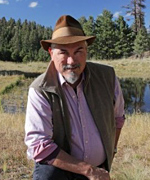Last month, I described the lawsuit brought by BLM and other plaintiffs against ADWR over the issuance of a Designation of Adequate Water Supply to Pueblo del Sol Water Company in Cochise County. The BLM, which manages the San Pedro Riparian National Conservation Area, asserted superior Federal rights to sufficient water to maintain perennial flows in the San Pedro — even though such rights have not been adjudicated. They argued that ADWR incorrectly issued the Designation because the criterion of legal availability had not been adequately evaluated since SPRNCA surface water rights had been ignored. And ADWR lost. The Superior Court judge agreed with the plaintiffs and ruled that ADWR’s decision to issue the Designation of Adequate Water Supply was in error. Appeals will continue for years.
I told you that story so I could tell you this one.
Back when I was working at ADWR, I routinely approved dozens of Water Reports as “inadequate.” Under rule, requirements for a Certificate of Assured Water Supply and an adequate Water Report are almost identical (physical, legal, and continuous availability for 100 years), except that Certificate applicants had to show compliance with the Management Plan for the AMA and how they would meet the management goal — in other words, join CAGRD. Thing was, the rural developer could get a Public Report issued by the Arizona Department of Real Estate, and thus plat approval, even with a Water Report that said the physical supply was inadequate. This was because the thrust of the two programs differed: The Assured Water Supply program aimed at insuring AMA subdivisions had real water that was replenishable, and the Adequate Water Supply program was merely a consumer advisory, available only to the first purchaser of a lot. Lack of a Certificate meant no subdivision, and developers took it seriously, but an inadequate Water Report meant virtually nothing, just a line buried in the ADRE Public Report that no one read anyway. I’ve seen chickens with more teeth.
In the boom times, many rural developers didn’t even try to meet the criteria for an adequate determination; it was quicker and easier to get ADWR to spit out an inadequate Water Report and take that to ADRE for inclusion in the Public Report. It didn’t impact sales. But it did impact residents in a few subdivisions when the water ran out. In recognition of the problem, the Statewide Advisory Group recommended measures that allow the Water Adequacy program to become more enforceable in rural Arizona.
SB 1575 was passed in 2007 with the support of many stakeholders. Counties were granted authority to require an adequate Water Report prior to plat approval, but only with the unanimous vote of the Board of Supervisors. Rural cities were likewise allowed to adopt the more stringent requirement with the unanimous vote of their councils. Two counties, Cochise and Yuma, did vote to adopt the requirement, and Mohave County failed by only one vote. The overall goal of allowing greater local control, if wanted, was achieved. The more enforceable Water Adequacy program benefits rural Arizona, particularly the high-growth counties like Cochise County, where groundwater supplies are limited and should not be over-allocated.
Fast forward to 2016. The lawsuit filed by BLM challenging ADWR’s issuance of a Designation of Adequate Water Supply in Cochise County was based on the question of legal availability. The possibility of BLM winning in the appeals process worries the City of Sierra Vista, which was counting on the 7,000 home master-planned community named Tribute to provide housing, jobs, and population growth for the next several decades. If the plaintiffs win at the Supreme Court level, Pueblo del Sol will lose its Designation, Cochise County cannot approve the plat, and no houses will ever be built in Tribute. So City officials felt they had to do something to salvage the situation.
This is the background behind SB 1268. With the full backing of the City of Sierra Vista, Senator Gail Griffin of Cochise County introduced a bill to essentially roll back the requirement for a favorable determination of physical, legal, and continuous availability by retroactively requiring cities in counties that passed the requirement to opt in to the program. Recall that a unanimous vote of the Cochise County Board of Supervisors was required to pass the requirement at all, which represents local control — and not all counties did it.
Sierra Vista has no intention of opting in. Sierra Vista believes that by removing the requirement for legal availability, the BLM lawsuit becomes moot, and Tribute can be built because Pueblo del Sol Water Company won’t need a Designation of Adequate Water Supply for plat approval. Déjà vu: It will be pre-2007 all over again.
The Water Adequacy program needed enforceability in 2007, and granting that authority to rural counties and cities was good water policy. Rolling back the ability of all counties to make water adequacy a requirement for platting subdivisions, just for the sake of one subdivision, would be bad water policy for Arizona. It is bad policy to gut the local control element of a good planning tool. It is bad policy to base economic development on an inadequate water supply. Let us hope that the Legislature will see SB 1268 for what it is.
